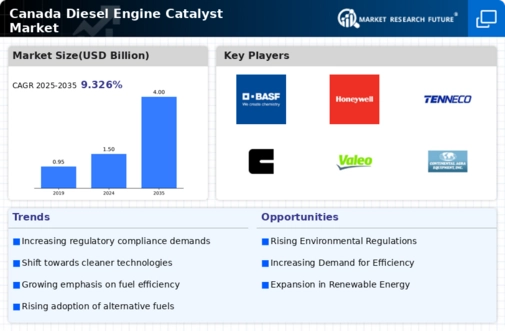The Canada Diesel Engine Catalyst Market is characterized by a dynamic competitive landscape driven by regulatory demands for emissions reduction and innovations in catalytic technologies. With increasing environmental awareness, the market is witnessing a shift towards advanced diesel engine catalysts that enhance performance while meeting stringent emission standards. As companies innovate and adapt to market trends, competitive strategies are becoming increasingly sophisticated, focusing on parameters such as product efficiency, sustainability, and collaboration with automotive manufacturers.
The landscape is shaped by key players who are continuously vying for a bigger market share through product differentiation and technological advancements, backed by significant investments in research and development. In this competitive realm, BASF stands out with a robust portfolio of environmentally friendly diesel engine catalysts that address the unique needs of the Canadian market. The company has cultivated a strong market presence thanks to its extensive experience in catalysis and commitment to sustainability. BASF focuses on developing innovative solutions that not only fulfill emissions regulations but also enhance engine efficiency.
Its strengths lie in advanced catalyst technologies and its ability to deliver tailored solutions that meet the specific performance needs of clients in Canada. Additionally, BASF’s strong manufacturing capabilities, along with its collaborative approach with automotive manufacturers, help it maintain a competitive edge in the market, allowing the company to respond swiftly to changing customer requirements and trends in the industry.Honeywell also plays a significant role in the Canada Diesel Engine Catalyst Market with its comprehensive range of advanced catalytic solutions.
Honeywell is recognized for its innovative technology offerings, which include catalysts designed to optimize diesel engine performance, meet environmental regulations, and improve fuel consumption.
The company’s strong presence in the Canadian market is bolstered by its commitment to research and development, which enables it to stay at the forefront of technological advancements. Honeywell leverages key products that cater specifically to diesel emissions control, enhancing its market appeal. Furthermore, the company often pursues strategic mergers and acquisitions, allowing it to expand its product offerings and strengthen its foothold in Canada, contributing to ongoing innovations in the diesel engine catalyst domain. Through these strategic initiatives, Honeywell effectively enhances its ability to meet customer demands while adhering to the evolving regulatory standards in Canada.






















Leave a Comment